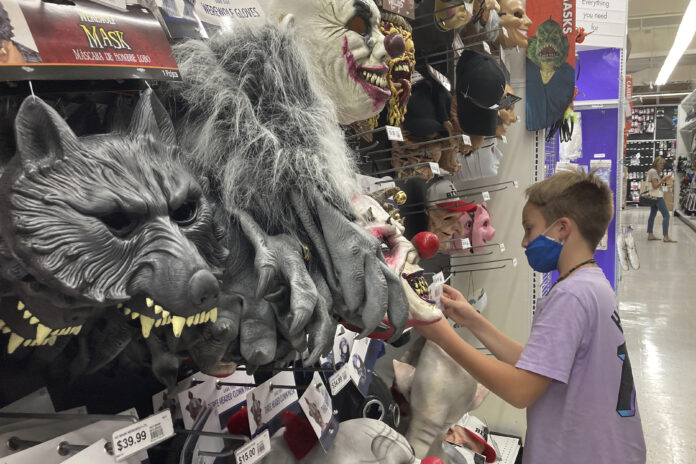
NEW YORK (AP) – Americans continued to spend at a solid clip in September even while facing sticker shock in grocery aisles, car lots and restaurants as snarled global supply chains slow the flow of goods.
Retail sales rose a seasonally adjusted 0.7% in September from the month before, the U.S. Commerce Department said Friday. While that was a bigger number than economists had expected, concerns are mounting as to how resilient shoppers will be as they head into the crucial holiday season, should rising prices stick and frustrations grow amid short supplies.
Consumer activity drives about 70% of the U.S. economy.
Right now, however, there is no evidence that Americans are pulling back and the spending last month was broad-based. Sales at clothing and accessories stores rose 1.1%, while sales at department stores rose 0.9%. That’s a sign that people are splurging for new clothes for the back-to-school season or for a return to the office. Shoppers also opened their wallets at sporting goods, hobby stores and books stores where sales rose a 3.7%.
Online sales increased 0.6%. Sales at gasoline stations rose 1.8%. And sales at restaurants and bars, many of which believed they were through the worst of the pandemic until the arrival of the delta variant, rose 0.3% from the previous month.
Some of the increased spending is being caused by rising prices. The U.S reported this week that the prices consumers pay rose 0.4% in September, and they’re up 5.4% over the past 12 months, matching the fastest pace since 2008. Gasoline, furniture, cars and trips to the grocery store or restaurant have all grown more expensive.
“American consumers still have plenty left in the tank despite some tough-to-find and pricier items,” wrote Sal Guatieri, senior economist and director at BMO Capital Markets, in a report published Friday.
Guatieri was particularly surprised by the willingness of Americans to continue buying cars with dealerships running short on supply and manufacturers shutting down factories due to a lack of essential computer chips. Yet there was a 0.6% increase in sales at auto dealers, after a plunge last month.
While the spending increases have been broad, the delta variant had has an influence on where Americans are spending money, with more dollars devoted to buying things, rather than plane tickets or dinners out.
The monthly retail report covers only about a third of overall consumer spending, however, and doesn’t include services such as haircuts, hotel stays and plane tickets. Spending has weakened in some of these areas.
Airlines, for example, recently started to report declining ticket sales. They have blamed the spread of the delta variant.
“A lot of gains continue to come from a diversion of spend from services to spending on products,” said Neil Saunders, managing director at GlobalData Retail. “Consumers continue to travel, commute and vacation less than they did pre-pandemic, and the expenditure that would normally be made on these activities has found a new home in retail.”
But there are plenty of worries heading into the crucial holiday season as retailers grapple with worker shortages and festering supply chain issues.
Toy companies, manufacturers and clothing companies have been plagued by snags in the supply network such as a shortages of ship containers. Some are leaving a bulk of their goods in China as they wait for shipping costs to retreat.
And hiring has slowed in the past two months, even as companies and other employers post a near-record number of open jobs. In the run-up to the holiday season, businesses are struggling to find workers. About three million people who lost jobs and stopped looking for work since the pandemic have yet to resume job searches, according to recent economic data.
“The main concern now is that supply-chain disruptions and microchip shortages appear to be spreading, limiting selection and tamping down goods demand, “wrote Guatieri. “Meantime, services demand is getting held back by labour shortages, notably in restaurants. Demand isn’t the problem, supply is. “
Also worth nothing, while spending was solid in September, it was the weakest growth since March, Saunders said. The momentum will not continue indefinitely, he said, and will continue to trend down until it reaches more normalized levels, he said.
“There might be some variation during the final months of the year if consumers decide to go on a big spending spree to celebrate the holidays, but this will be the exception rather than the rule, ” he added.
Anne D’Innocenzio is an AP retail writer.












